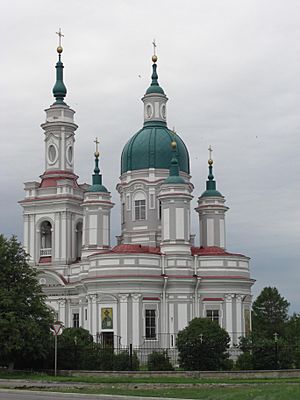Antonio Rinaldi (architect) facts for kids
Antonio Rinaldi (born August 25, 1709, in Palermo, Italy – died April 10, 1794, in Rome, Italy) was a famous Italian architect. He learned his skills from another great architect, Luigi Vanvitelli. Rinaldi spent most of his career working in Russia, where he designed many important buildings.
Contents
Rinaldi's Early Work
In 1751, Antonio Rinaldi traveled to England. While there, he was asked by a powerful leader named Kirill Razumovsky to help decorate his homes in Ukraine. During this early time, Rinaldi designed some beautiful churches.
Churches in Russia
- He built the Resurrection Cathedral in Pochep, near Bryansk.
- He also designed the Catherine Cathedral in Yamburg (now called Kingisepp), near St Petersburg. This church is shown in the picture at the top of this article.
Rinaldi was very good at combining traditional Russian church styles with the fancy Italian Late Baroque style. He created buildings with round domes and central layouts, which were common in Russian Orthodox churches.
Working for the Russian Court
Rinaldi's first big project for a non-royal person was the Novoznamenka chateau for Chancellor Woronzow. In 1754, he became the main architect for the "young court." This meant he worked for the future rulers of Russia, Peter III and Catherine II. They lived in a place called Oranienbaum.
Famous Designs in Oranienbaum
In Oranienbaum, Rinaldi created some of his most well-known baroque buildings:
- The Palace of Peter III (built from 1758 to 1760).
- The Chinese Palace (built from 1762 to 1768), which was decorated in a very rich and detailed style.
- The Ice-Sliding Pavilion (built from 1762 to 1774), a unique building for winter fun.
Projects for Count Orlov
In the 1770s, Rinaldi worked as the main architect for Count Orlov. Count Orlov was a very important person and a close friend of Empress Catherine II. During this time, Rinaldi designed two grand buildings in the Neoclassical style:
- The Marble Palace in St Petersburg, located on the Palace Embankment.
- The large Gatchina Castle. This castle was later bought by Emperor Paul and changed a bit.
Rinaldi also designed several monuments for Count Orlov in Tsarskoe Selo. These include:
- The Orlov Gates.
- The Kagul Obelisk.
- The Chesma Column.
He also finished the work on the Catholic Church of St. Catherine in St Petersburg, which had been started by another architect, Jean-Baptiste Vallin de la Mothe.
Later Works and Style Change
Rinaldi's final projects show how his style changed over time. He moved from the very fancy and detailed rococo style, often seen in interiors, to a more simple and clear style for building exteriors. This new style is known as Neoclassicism.
Notable Cathedrals
His later works include two cathedrals in St Petersburg:
- One was dedicated to St Isaac the Dalmatian. This church was later taken down to make way for the much larger current Empire-style building.
- The other is dedicated to Prince Vladimir and is still standing today.
End of Life
In 1784, Antonio Rinaldi retired from his work because of poor health. He then returned to his home country, Italy. He passed away in Rome in 1794.
See Also
 In Spanish: Antonio Rinaldi para niños
In Spanish: Antonio Rinaldi para niños


